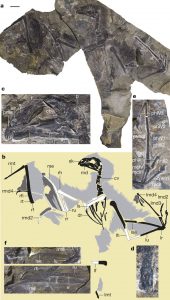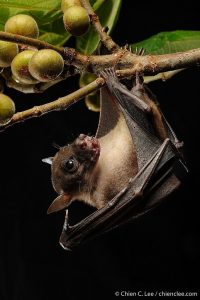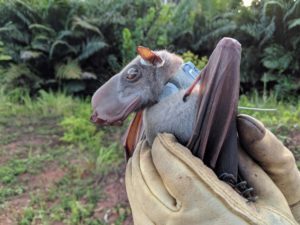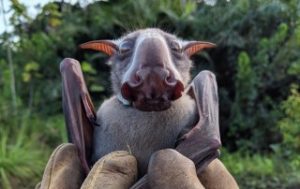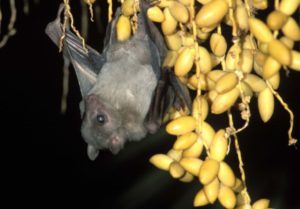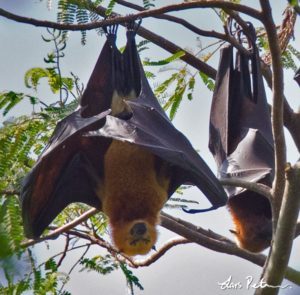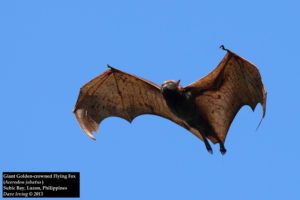Podcast: Play in new window | Download (Duration: 10:37 — 11.7MB)
This week we learn about the fossa and a few other animals of Madagascar, a suggestion by Pranav!
Further reading:
The fossa!
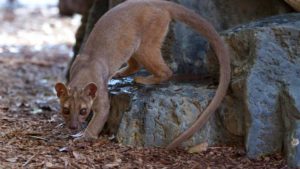
The votsotsa is a rodent, not a rabbit! [photo by Andrey Giljov – Own work, CC BY-SA 4.0, https://commons.wikimedia.org/w/index.php?curid=113271739]:
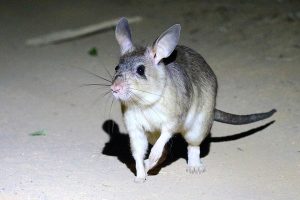
The golden mantella frog is sometimes golden, but sometimes red:
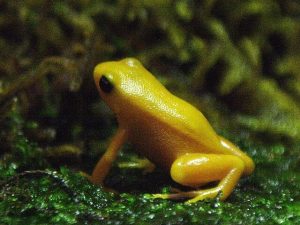
The nano-chameleon may be the smallest reptile in the world:
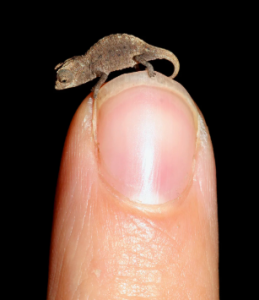
Show transcript:
Welcome to Strange Animals Podcast. I’m your host, Kate Shaw.
This week we have a very old Pranav suggestion, animals of Madagascar!
The island country of Madagascar is off the southeastern coast of Africa. About 88 million years ago, it broke off from every other landmass in the world, specifically the supercontinent Gondwana. The continent we now call Africa separated from Gondwana even earlier, around 165 million years ago. Madagascar is the fourth largest island in the world and even though it’s relatively close to Africa these days, many of its animals and plants are much different from those in Africa and other parts of the world because they’ve been evolving separately for 88 million years.
But at various times in the past, some animals from Africa were able to reach Madagascar. We’re still not completely sure how this happened. Madagascar is 250 miles away from Africa, or 400 kilometers, and these days the prevailing ocean currents push floating debris away from the island. In the past, though, the currents might have been different and some animals could have arrived on floating debris washed out to sea during storms. During times when the ocean levels were overall lower, islands that are underwater now might have been above the surface and allowed animals to travel from island to island until they reached Madagascar.
We’re not sure when the first humans visited Madagascar, but it was at least 2,500 years ago and possibly as much as 9,500 years ago or even earlier. It’s likely that hunting parties would travel to Madagascar and stay there for a while, then return home with lots of food, but eventually people decided it would be a nice place to live. By 1,500 years ago people were definitely living on the island.
Let’s start with the fossa, an animal we’ve only talked about on the podcast once before, and then only in passing. It resembles a type of cat about the size of a cougar, although its legs are short in comparison to a similarly-sized cat. Its tail is almost as long as its body, and if you include its tail, it can grow around five feet long, or 1.5 meters. It’s reddish-brown with a paler belly. Its head is small with a short muzzle, rounded ears, and big eyes.
But the fossa isn’t a felid. It resembles a really big mustelid in many ways, especially a mongoose, and some studies suggest it’s most closely related to the mongoose. Really, though, it’s not closely related to anything living today. It spends a lot of time in trees, where it uses its long tail to help it balance. It even has semi-retractable claws. It eats lemurs and other mammals, birds, insects, crabs, lizards, and even fruit.
There used to be an even bigger fossa called the giant fossa, although we don’t know much about it. We only know about it from some subfossil remains found in caves. We’re not sure how big it was compared to the fossa living today, but it was definitely bigger and stronger and might have grown 7 feet long including its tail, or a little over 2 meters. There used to be much bigger lemurs living on Madagascar that have also gone extinct, so the giant fossa probably evolved to prey on them.
Most scientists estimate that the giant fossa went extinct at least 700 years ago, but some think it might have survived in remote areas of Madagascar until much more recently. There are even modern sightings of unusually large fossas, sometimes reported as twice the size of a regular fossa.
One interesting thing about the fossa is that its anus is hidden most of the time by a little fold of skin called an anal pouch, sort of like built-in underwear.
One animal most people outside of Madagascar have never heard of is the votsotsa, also called the Malagascar giant rat or the giant jumping rat since it’s a rodent that is especially known for its ability to jump. It actually looks a lot like a rabbit in size and shape, including its long ears, but it has a long tail. It’s gray or brown in color and grows about a foot long, or 30 cm, with a tail that can be up to 10 inches long, or 25 cm.
The votsotsa mates for life and both parents raise the single baby the mother gives birth to once or twice a year. It’s a nocturnal animal that spends the day in its burrow, which can be as much as 16 feet long, or 5 meters, with multiple exits. It eats nuts and seeds, fruit, leaves, and other plant material, along with insects and other small animals.
Lots of bats live on Madagascar, including the Madagascar flying fox. It’s a fruit-eating bat that’s brown or golden-brown in color with gray or black wings, and it’s the biggest bat native to the island. It has a wingspan of more than four feet across, or 125 cm. Like other species of flying fox, it lives in colonies of up to a thousand individuals that roost together in trees during the day. It mostly forages in the evenings, searching for fruit like figs. It eats flowers and sometimes leaves as well as fruit, and it may even be a pollinator for the kapok tree’s flowers.
Naturally, Madagascar also has a lot of reptiles, amphibians, and other non-mammalian animals. For instance, the golden mantella frog. It’s a little frog that’s only found in a few small areas, and measures around 20 millimeters long snout to vent. Some individuals are golden yellow while others are bright orange or red. As you may remember from our many previous episodes about frogs, such bright colors act as a warning to potential predators, to let them know that the frog is toxic. It absorbs toxins from some of the insects it eats. It’s active during the day in summertime, and in winter it spends most of the time hiding and doing nothing, which is the best way to spend the winter.
There are also lots of chameleons on Madagascar, including one called the nano-chameleon. It gets its name from its size, which is extremely small. It’s the smallest chameleon in the world, only 29 mm long at the very most, which is barely more than an inch long. Males are smaller than females, usually around 22 mm. It was described in 2021 and is brownish-grey with pale yellow or yellow-brown markings. Chameleons are famous for changing color, but the nano-chameleon doesn’t. It also mostly lives on the ground, where it hunts tiny insects and other invertebrates. Some scientists think it may be the smallest reptile in the world.
The female Darwin’s bark spider is about the same size as the female nano-chameleon, if you don’t count the spider’s legs. Males are much smaller. Darwin’s bark spider is a type of orb-weaver, which is the kind of spider that spins large webs that look like Halloween decorations. It was described in 2010 after first being discovered by scientists in 2009, which is surprising because it builds the largest orb webs known. Some webs can be over 30 square feet in size, or 2.8 square meters.
The silk is the strongest biological material ever studied, twice as strong as any other spider silk studied. The spider builds its web over water, because it eats a lot of mayflies and other insects that are attracted to water. It also eats a lot of dragonflies, and dragonflies are quite large and strong insects that don’t usually get caught in spiderwebs.
The people of Madagascar are considered very poor compared to other countries, after almost a century of French colonization and the resulting instability after it regained independence in 1960. A lot of animals that were once considered to be forbidden to bother, for religious and cultural reasons, now end up killed so people can eat them instead of starving. Mining and slash-and-burn agriculture has also contributed to pollution, habitat loss, and other factors that aren’t good for the animals of Madagascar or its people. Luckily, eco-tourism, where people visit the island to experience its beauty and see animals and plants found nowhere else on earth, is becoming more common. Hopefully that will help improve conditions for the people who live there and for the animals too.
You can find Strange Animals Podcast at strangeanimalspodcast.blubrry.net. That’s blueberry without any E’s. If you have questions, comments, or suggestions for future episodes, email us at strangeanimalspodcast@gmail.com. We also have a Patreon at patreon.com/strangeanimalspodcast if you’d like to support us for as little as one dollar a month and get monthly bonus episodes.
Thanks for listening!
